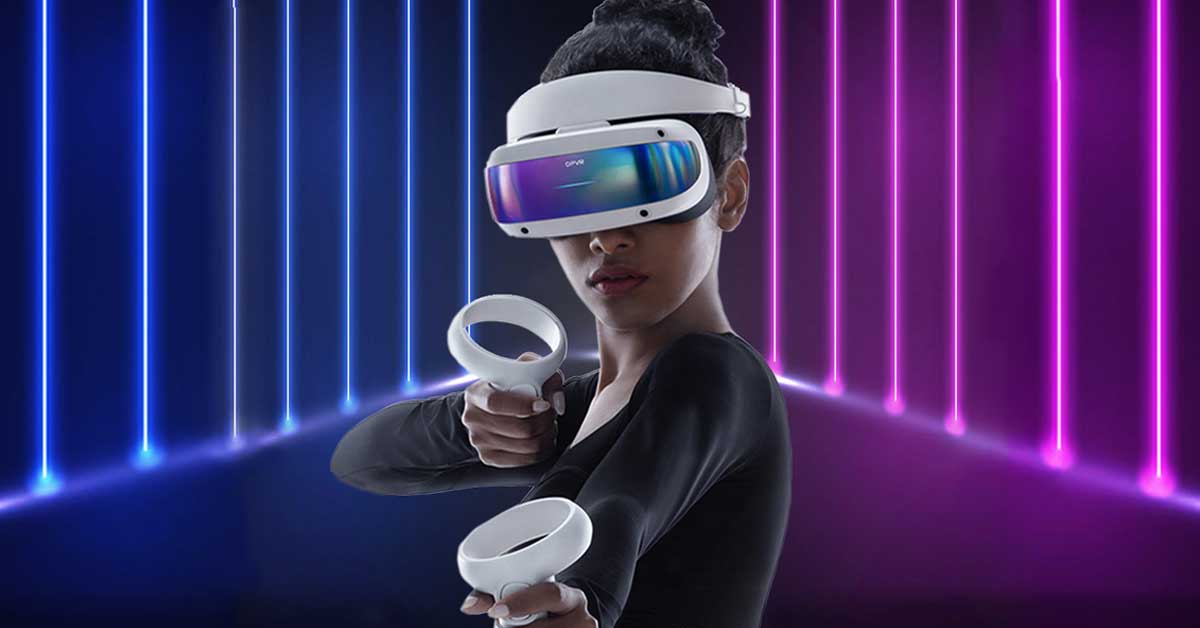-
Overall Design - 8.5/10
8.5/10
-
Sound & Visual Quality - 8/10
8/10
-
Comfort - 8/10
8/10
-
Controller Quality - 7/10
7/10
Summary
After spending quality time inside the virtual worlds created by the DPVR E4, we can comfortably say that it’s a keeper. It offers an engaging combination of affordability, performance, and comfort, making it a compelling option in the ever-evolving VR headset market. It’s not without its small quirks, but even those don’t diminish its luster in a significant way. Bottom line, the DPVR E4 VR Headset is a well-rounded performer that effectively blends professional-grade features with consumer-friendly ease.
Pros
- Outstanding visual fidelity
- Remarkably lightweight
- Comprehensive out-of-box package
- Solid battery life
Cons
- Tinny onboard audio
- Limited haptic feedback
A high-quality, top-performing VR headset is going to cost you a pretty penny. So when an affordable VR headset comes out of equal caliber, people take notice. Such is the case with DPVR’s E4 VR Headset.
Granted, there are less expensive options out there. But given what’s under the hood, this is one that you shouldn’t overlook.
So what is it exactly that elevates this headset to must-see status? That’s what we’re discussing today in our review of the E4. So stick around; you may have just found your next favorite VR headset.
What’s Included?
The moment you unbox this tech marvel, you’ll find more than just the standard headset and a couple of cords. The package includes:
- The E4 Headset
- 1x DP 1.4 cord
- 1x user manual and warranty information
- 1x power adapter
- 2x wireless controllers
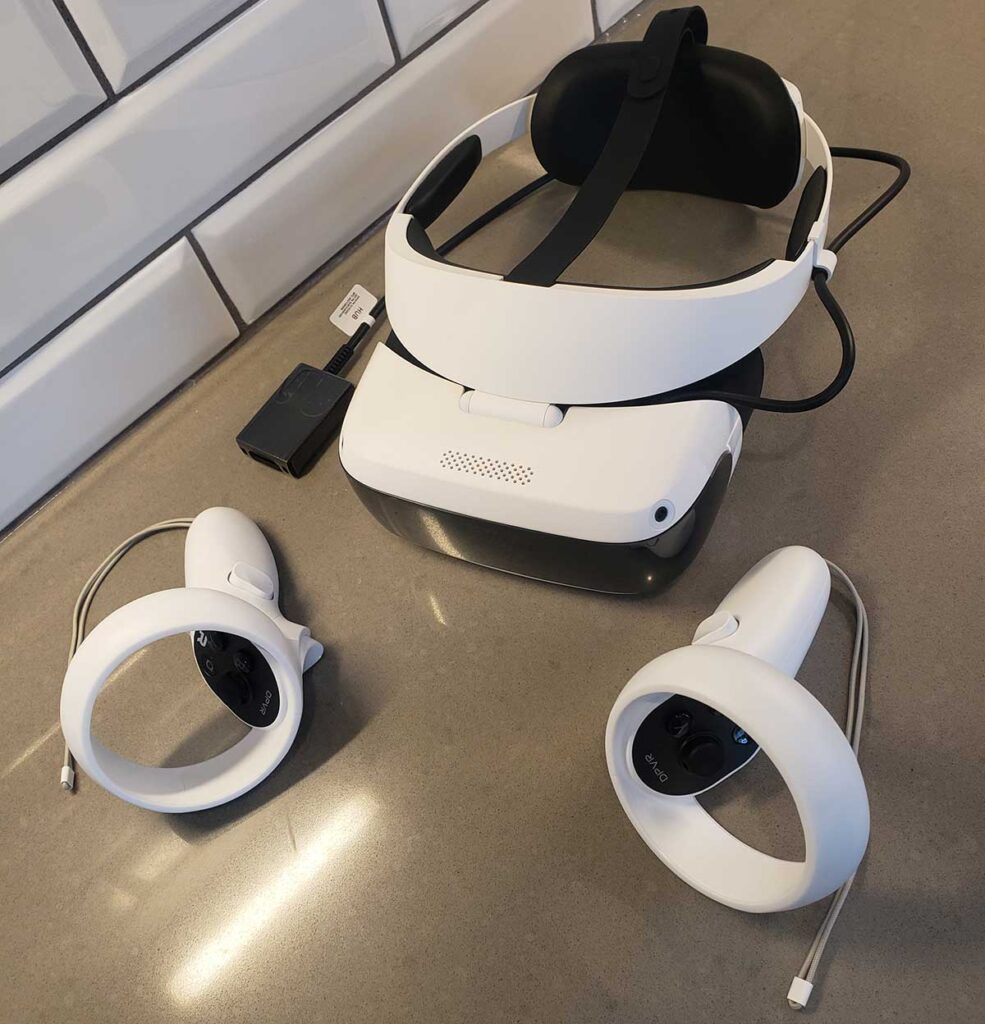
You’re essentially getting an all-in-one starter pack for your journey into the depths of virtual reality.
DPVR isn’t just giving you a headset; they’re giving you a full-package experience right out of the box. Controllers, cables, manuals – they’ve thought of it all. It’s a nice array of gadgets that sets the stage for the gaming ahead. All you need to provide are the games.
First Impressions
Upon cracking open the box, the first thing that stood out to us was the headset’s sleek, white design. It exudes professionalism and adventure at the same time. No garish colors, no excessive trimmings – just straight-up, no-nonsense gaming gear.
When turned on, an RGB light elegantly accentuates the headset, offering a taste of what’s to come. But it’s not just about the aesthetics. The weight and dimensions come into play here, as well.
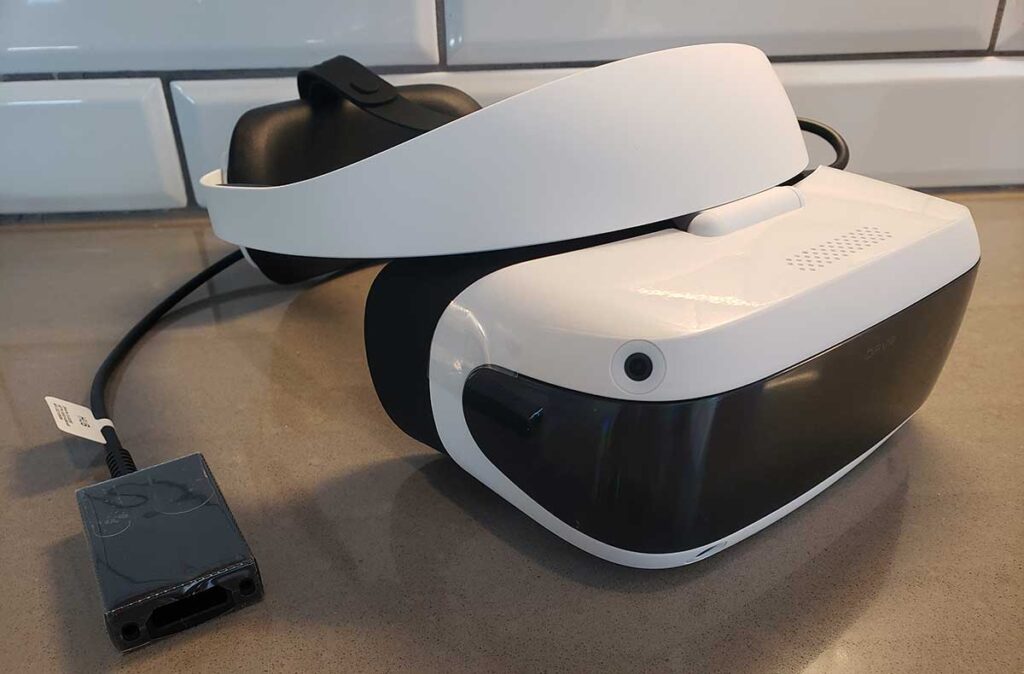
Measuring 11.34 x 7.68 x 4.65 inches and weighing in at a mere 1.18 pounds, it’s the epitome of lightweight comfort. This is the kind of gear you can wear for hours without feeling like you have a motorcycle helmet on your head.
Moreover, the integrated speakers and microphone hint at the kind of immersive social experiences you could be having in the near future.
So far, our first impression is a positive one. Up next, we’re exploring the headset’s performance and capabilities.
Headset and Visual Quality
Visuals in VR are not just bells and whistles; they are the core of the experience. During our test run of the E4, we noticed that the lack of image compression really does wonders for visual fidelity.
For instance, when playing graphically intense games like Half-Life: Alyx, the detailed environments and intricate textures were stunningly clear. The field of view (FOV) in the DPVR E4 also stood out, especially when compared to competitors like the Quest 2 and PICO 4.
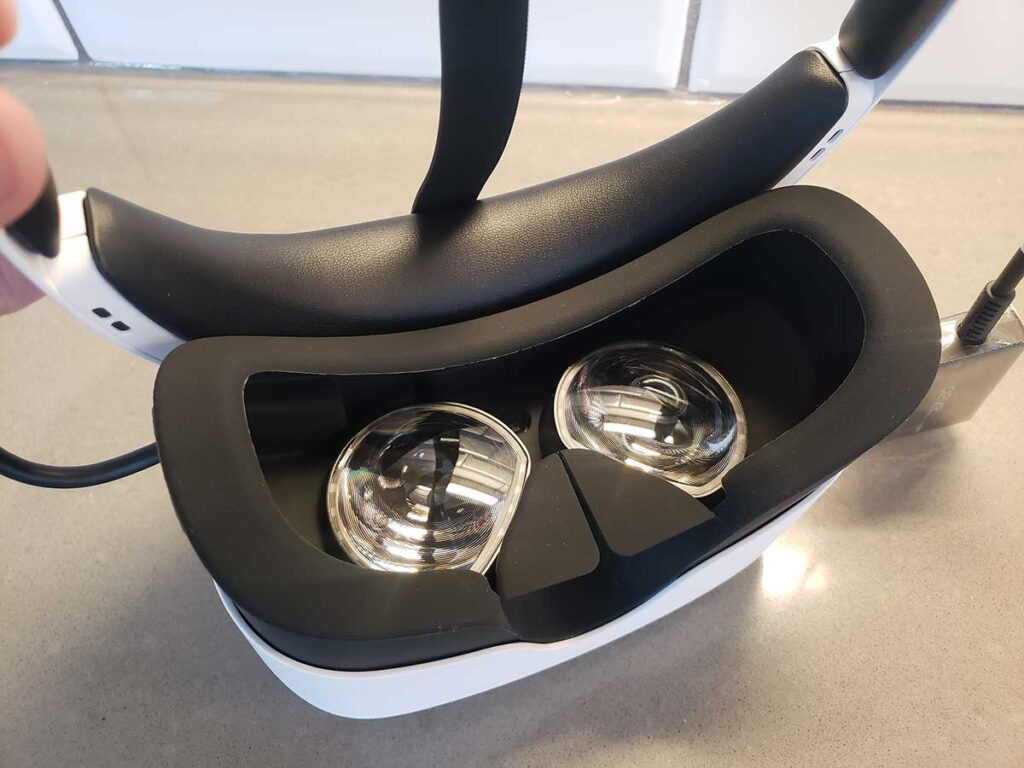
During our tests, the broader FOV significantly enhanced immersion in games and simulations. Imagine standing in the middle of an expansive virtual landscape, being able to see more of it without turning your head – it’s that level of enhancement.
Yes, LCD panels have their limitations, particularly when it comes to achieving deep blacks and vibrant colors. However, we found that the adjustable brightness settings do help in optimizing the visuals.
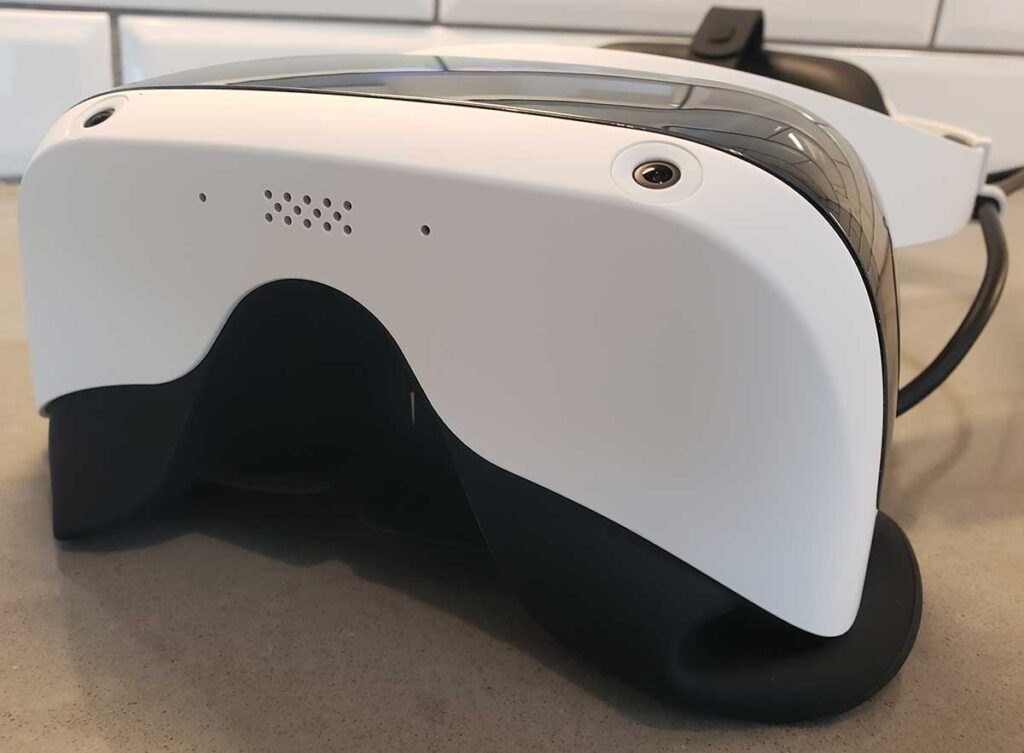
To gauge this, we increased the brightness from the default 25% up to 60%. This adjustment led to a more vibrant and engaging visual experience, especially in brighter games and experiences. Interpupillary Distance (IPD) is crucial for a comfortable VR experience.
While the E4 doesn’t offer physical adjustments for IPD, the software-based controls are effective. For instance, if you have a slightly below-average IPD of 61, you should be able to adjust the software settings for a comfortable viewing experience without feeling cross-eyed or strained.
Sound and Audio Quality
The E4 comes equipped with speakers located just above the ears on the head strap. During our test sessions, we found that while the audio was clear, it lacked a certain fullness, making it sound somewhat tinny.
In more ambient-focused games like Moss, the audio didn’t deliver the atmospheric richness we were hoping for. For those craving a more robust sound experience, the 3.5mm jack is a lifesaver. During our tests with external headphones, the sound output was noticeably richer and more immersive.
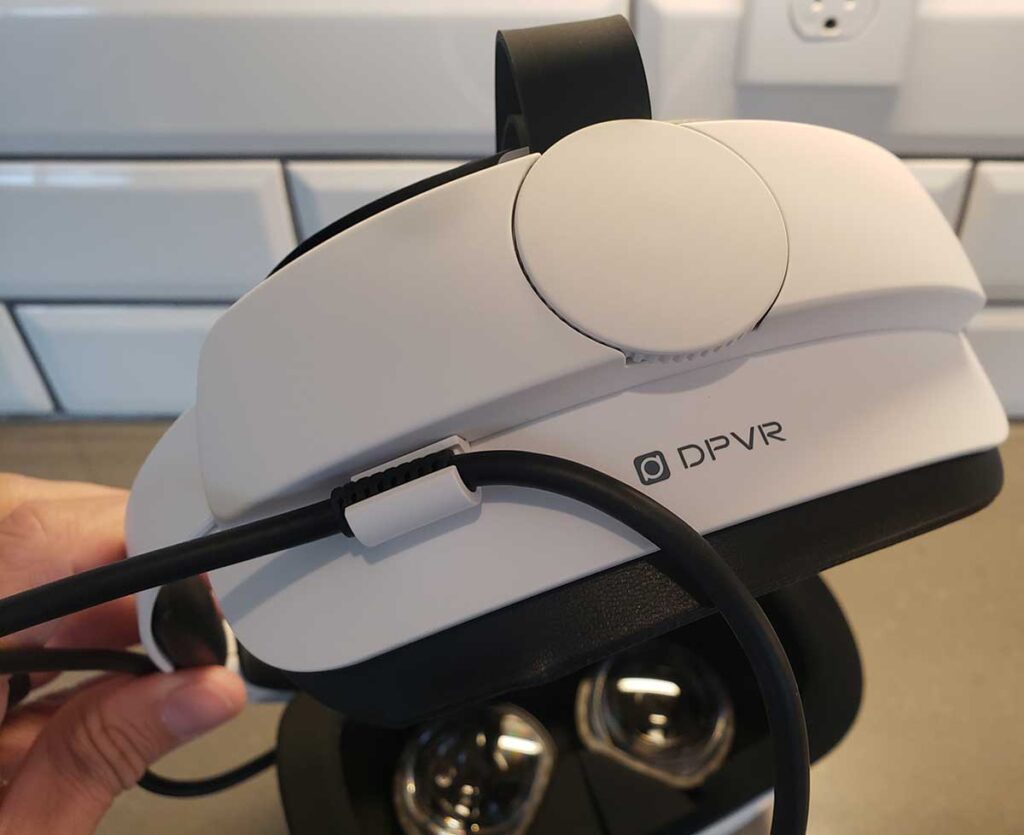
Plus, the cable management feature, allowing you to clip the wire to your clothing, ensures that you’re not wrestling with cables mid-game. The microphone on the E4 is sufficient for most standard in-game communications.
During multiplayer sessions in games like Vertigo 2, the microphone provided clear audio transmission, with teammates reporting no significant issues in understanding voice commands or casual conversation.
Bottom line, our thorough tests demonstrate that the DPVR E4 offers a well-rounded, high-quality experience both visually and audibly, affirming its solid position in the competitive VR marketplace.
Comfort and Feel
One of the first things that strike you about the DPVR E4 is its unexpectedly light weight. When you think “light,” your mind might default to “cheap” or “flimsy,” but let’s debunk that misconception right away.
The E4’s build quality feels solid and substantial. During testing, we found that this lightweight construction didn’t just make the E4 comfortable to wear; it was a game-changer in those longer VR sessions.
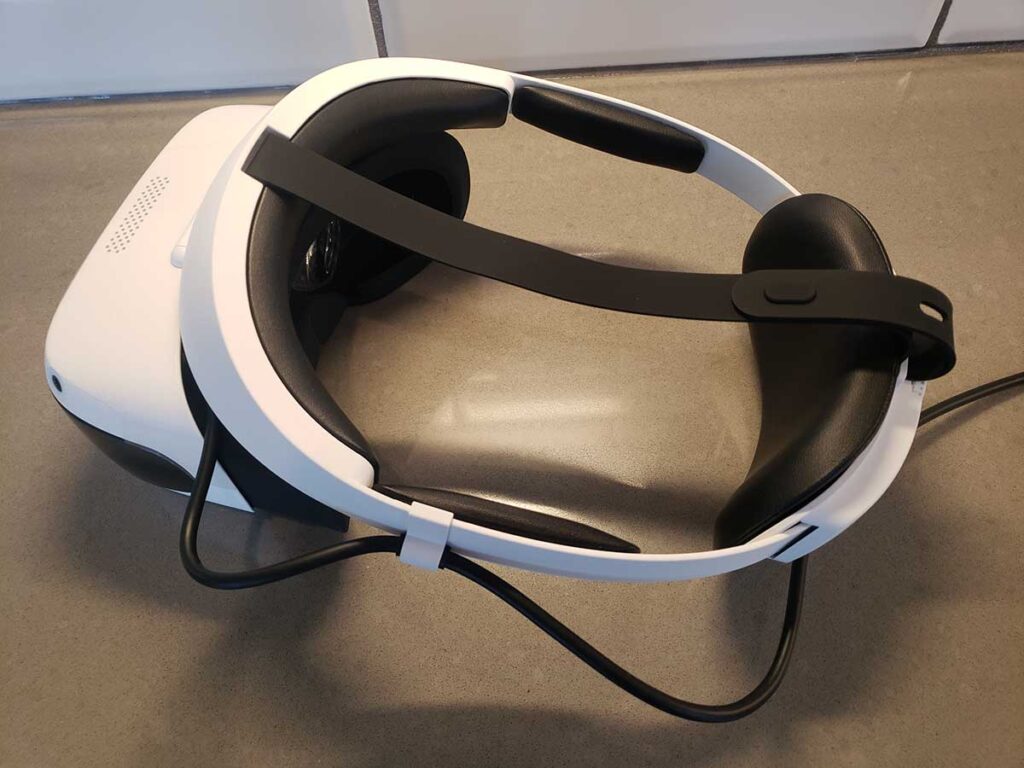
You’re not going to end a gaming marathon with a sore neck, which was sometimes the case with bulkier models like the HTC Vive. The E4 sports a halo strap, which has been gaining popularity in recent VR headsets.
The strap, in conjunction with the device’s lightweight nature, makes for an exceedingly comfortable experience. The rubber support across the top adds another layer of comfort, confirming that DPVR is going for gold in the comfort department.
In our extended use, the halo-strap lived up to its comfort billing. Long-term wear was a breeze, and we didn’t experience any of the discomfort or pinching sometimes found in older strap designs.
Moving on to the facial interface, the E4 utilizes soft rubber similar to the PSVR and PSVR2. This is great news for comfort and light leakage – two critical factors for immersion. When testing, we found that the soft rubber could conform to different facial shapes quite nicely.
No light leakage was detected, even when shifting our heads abruptly in reaction to game events. Another fascinating feature is the flip-up hinged design.
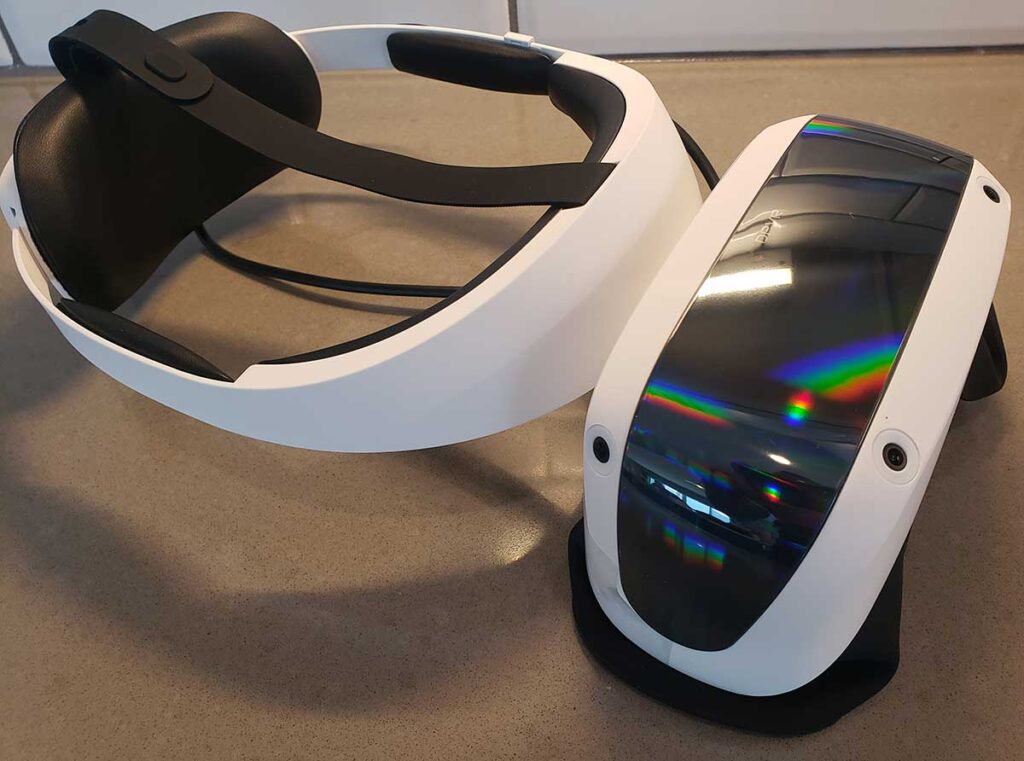
When you need to make a quick transition from virtual to actual reality – whether it’s to grab a sip of water or check your phone – the flip-up feature proves its worth. While the pass-through feature is handy, it’s not as advanced as some might be used to by 2023 standards.
A word of caution, though: putting the flip-up display back down might require a bit of finesse initially. But after a couple of tries, we figured out how to make it click back into place smoothly.
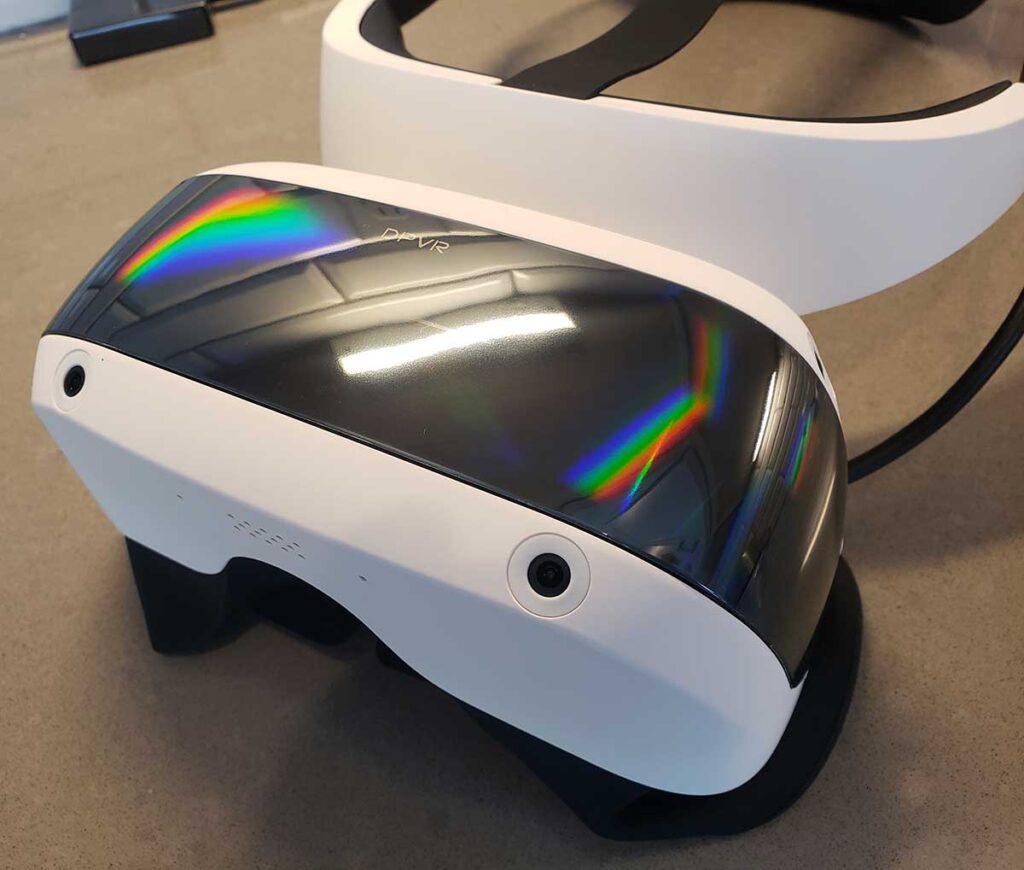
Last but certainly not least, let’s discuss cable management. The E4 features a clip on the back of the head strap and another on the cable itself. This double-clip action ensures the cable stays secure and unobtrusive.
Initially, we questioned the utility of this feature, but after a few active VR sessions, the benefit became clear. The cable stayed out of the way, making for a more enjoyable and less interrupted VR experience.
As you can see, the lightweight build and ergonomic design choices really go a long way in creating a comfortable user experience.
Controlling the DPVR E4
As with the headset, the controllers really impress with just how light they are. Even after inserting a single AA battery into each, they remain notably lightweight compared to their market counterparts.
But don’t let that fool you into thinking they’re frail. While the plastic might feel less luxurious compared to other controllers, our rigorous testing didn’t reveal any issues with build quality. These babies are built to last.
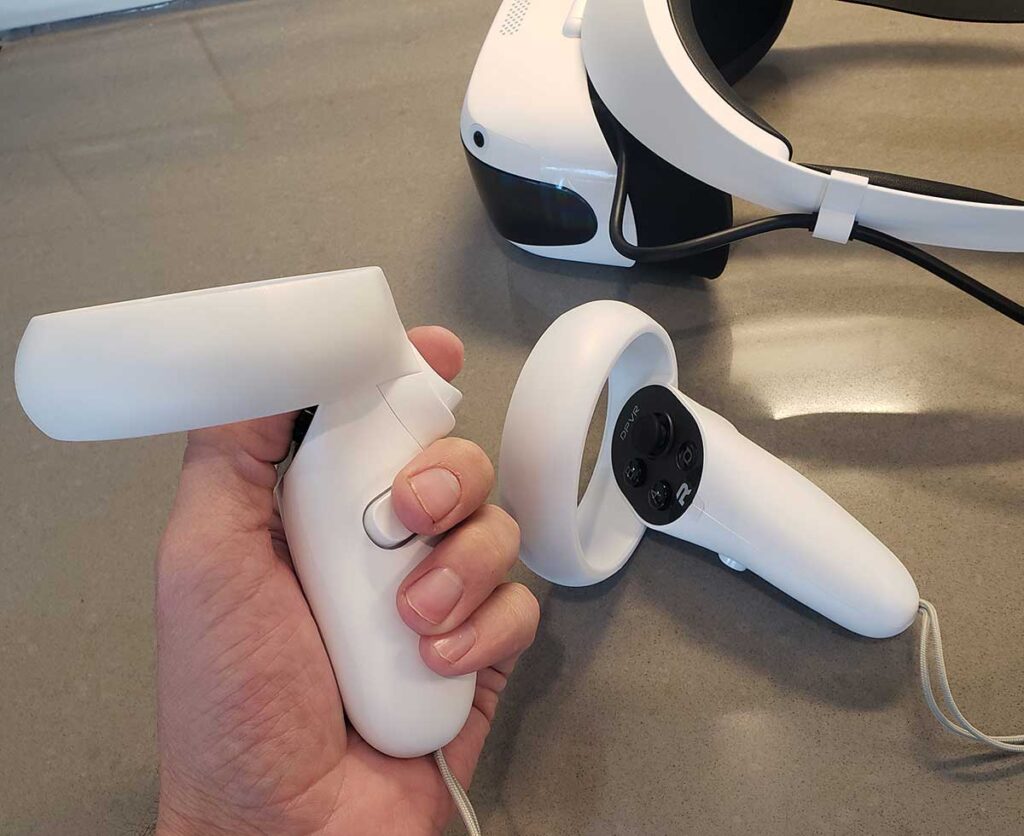
Initial concerns about battery life quickly fizzled out during our testing phase. Contrary to the battery-draining experiences we had with the original Quest and Rift S controllers, these ones hold their own quite well.
We found that even after the battery life indicator dropped to half, it stayed consistent throughout extended use. That means no game-time interruptions for a battery swap. At first glance, these controllers might remind you of the Quest 2 controllers.
The tracking ring is angled, and the overall surface area is smaller. However, these design modifications don’t negatively impact comfort or usability. The space between the analog sticks and buttons is ample, allowing for relaxed and natural hand movements.
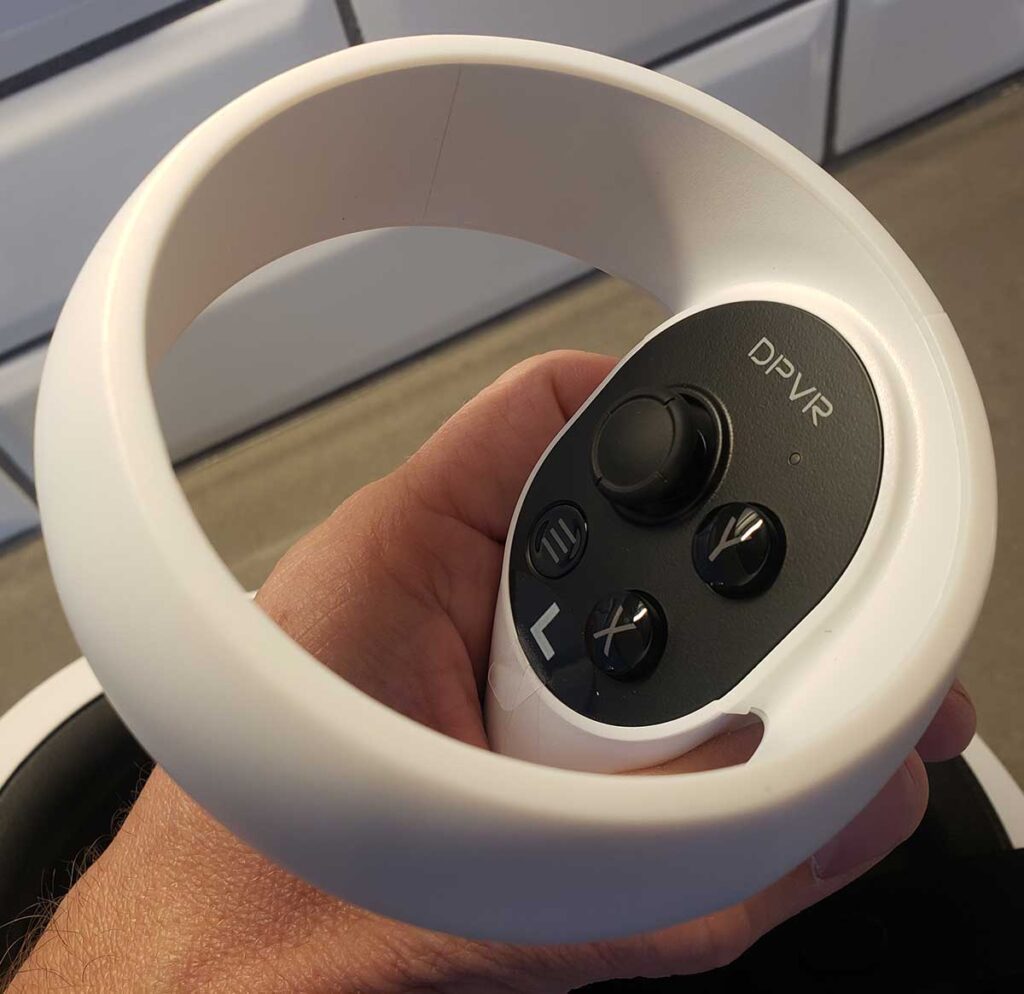
Inside-out tracking can be a tricky business; it often hinges on factors like room lighting. However, we found no significant issues here, whether testing in natural or artificial light. The only tracking issue occurred when holding the controllers down by our sides for an extended period.
It’s an issue not unique to the E4 but also present in devices like the Quest 2 and PSVR2. The DPVR Assistant software complements the E4 controllers nicely, offering customization options for various gaming needs.
You can choose between standard, analog, or trackpad settings, and the software even provides game-specific advice. In our tests, when a game wasn’t listed in the DPVR Assistant, toggling between the settings often led to a successful configuration.
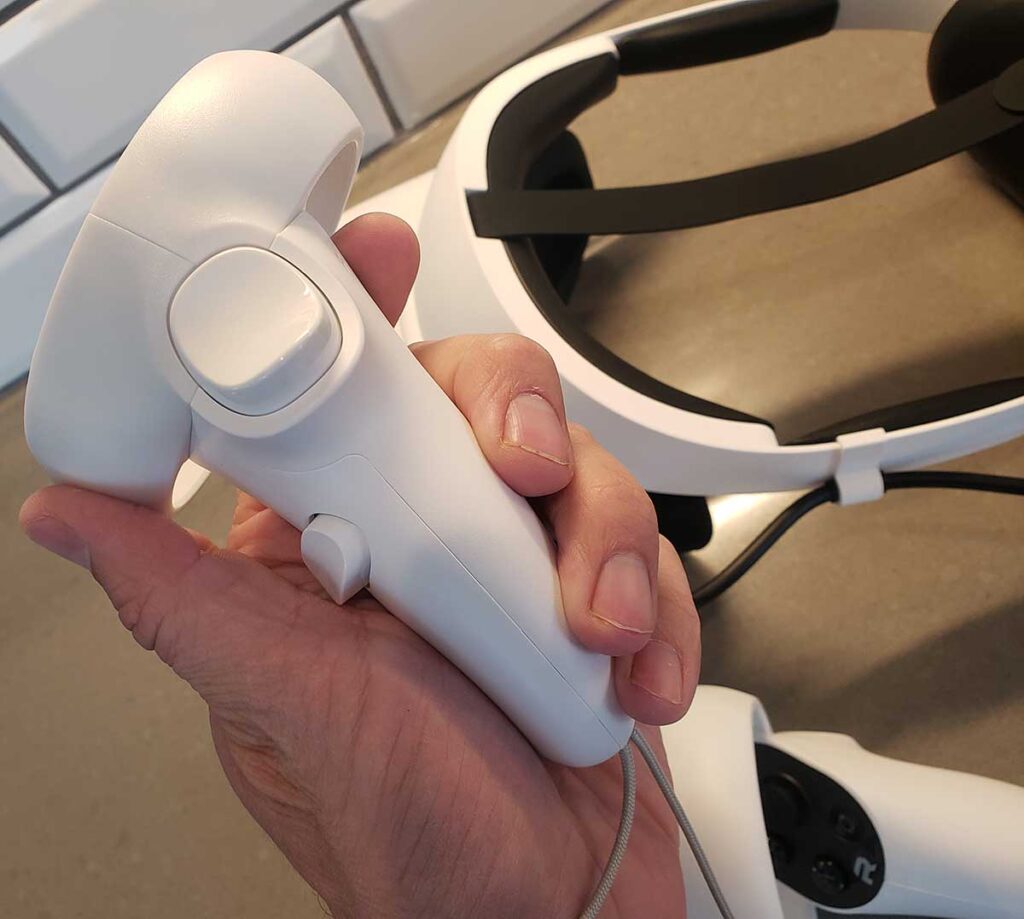
If there’s a fly in this otherwise well-mixed ointment, it’s the haptic feedback. In rhythm games where haptics are crucial, the controllers occasionally felt weak or unresponsive. We raised this concern with DPVR, and they assured us it’s on their radar for future firmware updates.
In all, the DPVR E4 controllers offer an excellent blend of lightweight construction, robust battery life, and reliable tracking. While there’s room for fine-tuning, particularly in the haptics department, they still form a solid pillar of the overall DPVR E4 experience.
Final Verdict
After spending quality time inside the virtual worlds created by the DPVR E4, we can comfortably say that it’s a keeper.
It offers an engaging combination of affordability, performance, and comfort, making it a compelling option in the ever-evolving VR headset market. It’s not without its small quirks, but even those don’t diminish its luster in a significant way.
Bottom line, the DPVR E4 VR Headset is a well-rounded performer that effectively blends professional-grade features with consumer-friendly ease.
Meet Ry, “TechGuru,” a 36-year-old technology enthusiast with a deep passion for tech innovations. With extensive experience, he specializes in gaming hardware and software, and has expertise in gadgets, custom PCs, and audio.
Besides writing about tech and reviewing new products, he enjoys traveling, hiking, and photography. Committed to keeping up with the latest industry trends, he aims to guide readers in making informed tech decisions.

